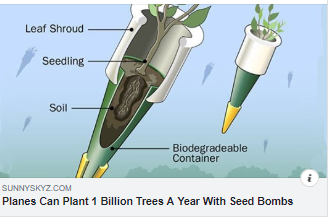Trees Sequester CO2 for Long Periods of Time

So, how does one plant trees in huge volumes? There are various approaches, but the common denominator involves drone aircraft.
Above we see a concept that embeds itself into the Earth. Other ideas contemplate balls that contain seed, soil and water that roll once they land, the exterior of which biodegrades rapidly upon impact.

Craig,
We all like trees! In the words of the American poet, Joyce Kilmer;
I THINK that I shall never see
A poem lovely as a tree.
A tree whose hungry mouth is prest
Against the sweet earth’s flowing breast;
A tree that looks at God all day,
And lifts her leafy arms to pray;
A tree that may in summer wear
A nest of robins in her hair;
Upon whose bosom snow has lain;
Who intimately lives with rain.
Poems are made by fools like me,
But only God can make a tree.
However, a less sentimental analysis reveals your “Johnny Appleseed” idea to be impractical and even environmentally harmful!
Firstly, not all trees “sequester”. Trees grown in mono-forests or arboreal stressed circumstances, emit both CO2 and large amounts of methane.
In fact, the largest source of atmospheric methane is derived from Trees!
Enthusiasm is great, but a little more research and a little less bling faith might me more appropriate.